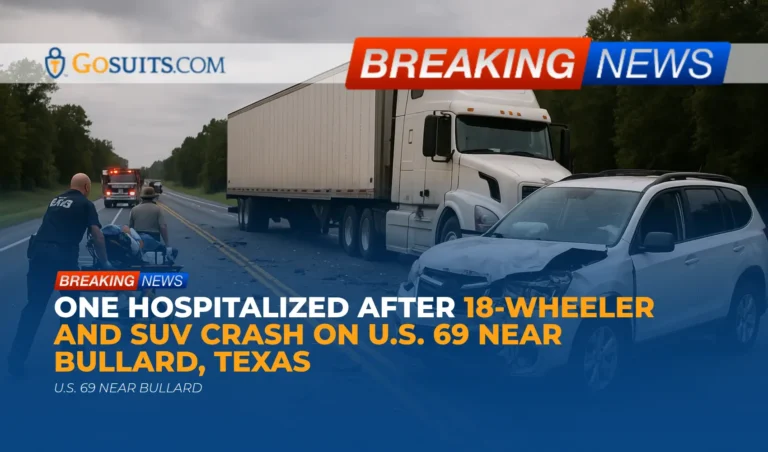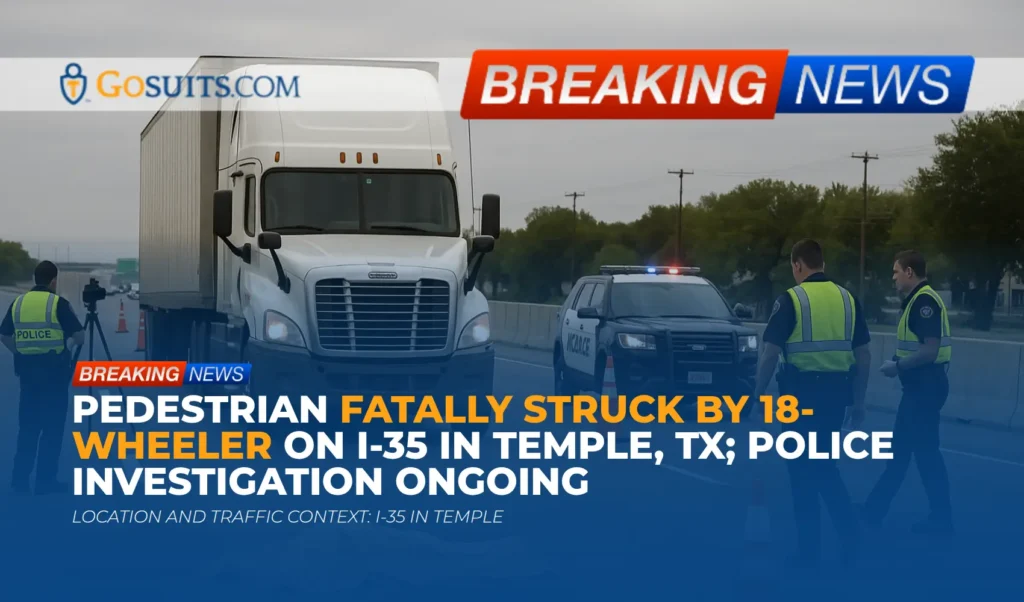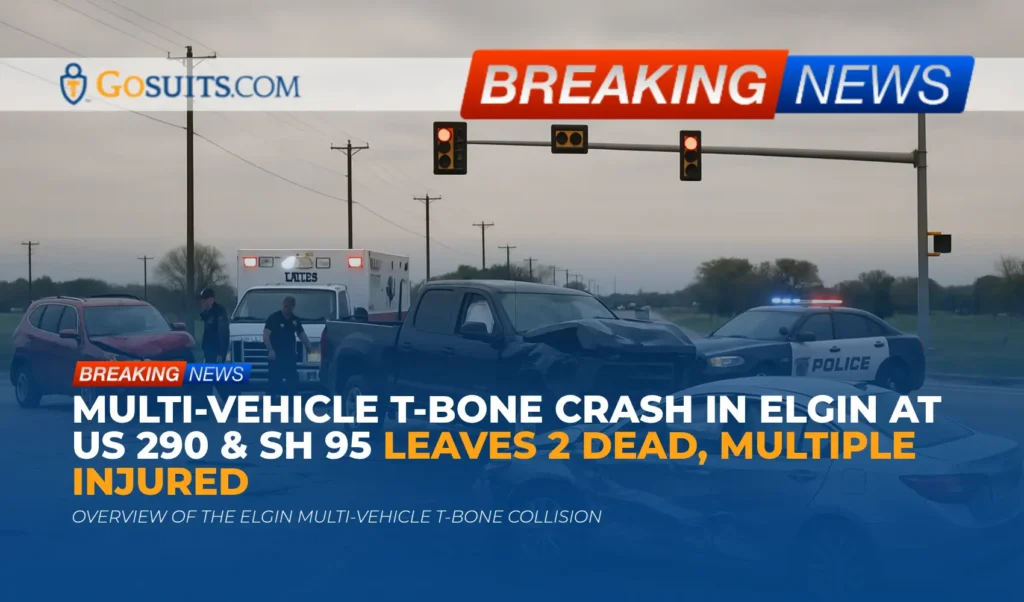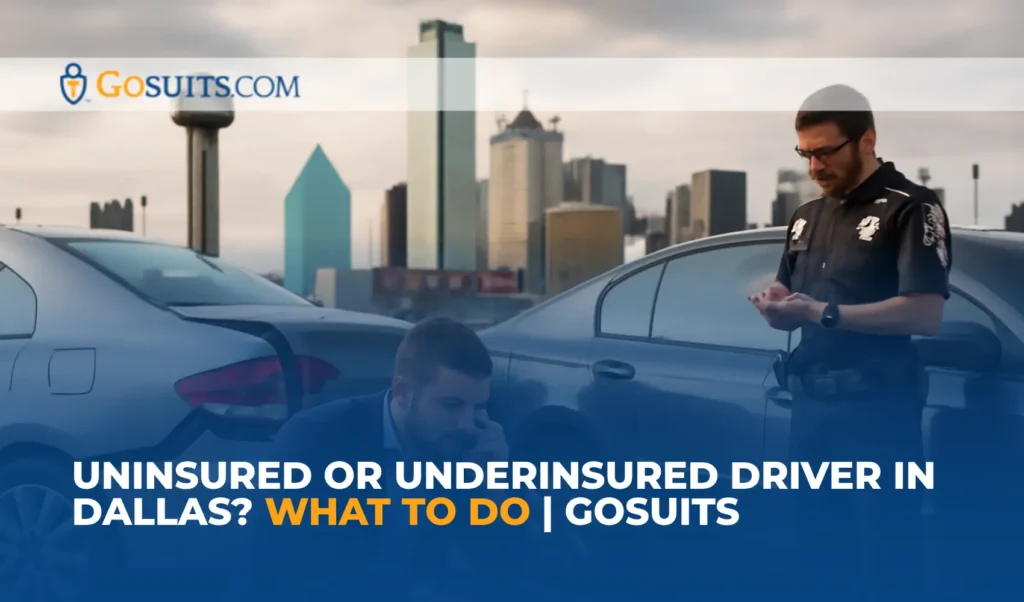- What We Know About the U.S. 69 Crash Near Bullard
- How Truck Turning and Merging Crashes Happen
- Immediate Steps After a Serious Truck-SUV Collision
- Records and Reports to Request, and Who to Contact
- Medical Records, Billing, and Insurance Coordination
- Texas Traffic Rules That Often Matter in Turn and Entry Crashes
- Key Trucking Safety Regulations That May Be Relevant
- Fault, Insurance, and Comparative Responsibility in Texas
- Evidence Preservation in Trucking Cases
- Timelines and Legal Deadlines to Keep in Mind
- Common Pitfalls to Avoid With Insurers and Claims
- Safety and Context: Large Truck Crash Data
- Why Acting Promptly Matters After a Highway Truck Crash
- Commentary from Gosuits Bullard, Texas Personal Injury Attorney
What We Know About the U.S. 69 Crash Near Bullard
According to information shared by state authorities, one person was hospitalized after an 18 wheeler struck a sport utility vehicle on U.S. 69 near Bullard in Smith County, Texas. The report indicates that the crash involved a man around 60 years old driving a white SUV northbound on U.S. 69. As an 18 wheeler was turning onto U.S. 69, the SUV driver reportedly attempted to speed up. The man was described as stable but was transported to a hospital for evaluation. Traffic in the area slowed while crews cleared debris from the roadway. The incident was reported on October 6, 2025.
While these are the basic facts available at this time, many important details typically need further documentation to understand what happened, including vehicle positions, turn movement, signal timing, sight lines, speed estimates, and any contributing factors such as driver attention, road design, or mechanical issues. That type of information is generally addressed in the official crash report and any supplemental scene documentation.
How Truck Turning and Merging Crashes Happen
Crashes that occur as large trucks turn onto a highway can develop quickly. A tractor trailer requires more time and distance to enter moving traffic due to its length, turning radius, and slower acceleration. If a truck begins a turn with an insufficient gap, or if approaching traffic accelerates into a narrowing gap, the margin for error disappears. Visibility around curves or over crests, sun glare at certain hours, and lane closures or construction can further complicate judging gaps.
Large trucks also have wider off-tracking and blind zones. The trailer can swing into an adjacent lane during a tight right turn, and the driver may lose sight of vehicles lingering near the cab or trailer. Conversely, a passenger vehicle driver might misjudge the truck’s speed or assume the truck will clear the lane faster than is realistic. These human factors are common in highway entry and turn collisions and are a main reason investigators look closely at right-of-way, turn paths, and the timing of movements of both vehicles.
Immediate Steps After a Serious Truck-SUV Collision
Every situation is unique, but the following actions often help protect health and preserve information after a serious crash. The points below are general information meant to help the community understand next steps.
- Prioritize medical evaluation. Even when someone feels “okay,” symptoms can appear hours or days later. Prompt medical care creates a clear record of injuries and a treatment plan.
- Document what you can safely. If conditions allow, note the exact location, direction of travel, lane positions, and any visible debris, skid marks, or vehicle fluids. Safe photographs of the scene and vehicles can be helpful later.
- Identify witnesses. If bystanders stopped, their names and contact information can be crucial. Independent witnesses often provide clarity on turn movements and right-of-way.
- Request the official crash report. In Texas, a CR-3 crash report is typically available from the state after processing. More on how to request it appears below.
- Notify your insurer, but proceed carefully. Policies often require timely notice. Before giving a recorded statement to any insurance company, including your own, it is wise to consult an attorney. What is said to an insurer can be used against the person later.
- Track expenses and time impacts. Keep records of medical visits, prescriptions, travel to appointments, repair estimates, and time missed from work. Documentation helps paint a full picture of the impact.
Records and Reports to Request, and Who to Contact
Obtaining complete documentation is essential. Below are common records and how to request them in Texas.
Official Texas CR-3 Crash Report
- Where the report comes from. In Texas, the official crash report is filed by the investigating agency and maintained by the Texas Department of Transportation.
- How to request. See the Texas Department of Transportation’s page on Crash Reports and Records for ordering instructions and eligibility under Texas Transportation Code 550.065: TxDOT Crash Reports and Records.
- Release restrictions. Crash reports have limited release to certain parties, including those involved, their representatives, or insurers, under Texas Transportation Code 550.065. Statutory details are available here: Transportation Code Chapter 550.
- Timeline. Reports typically become available within days to weeks depending on the investigating agency’s processing time.
Texas Highway Patrol Information
- Investigating agency. The initial information indicates the Texas Department of Public Safety Texas Highway Patrol responded.
- Contact. The agency’s main portal is here: Texas Department of Public Safety. You may ask for the District or Area Office that covers Smith County for non-emergency follow up about report availability and procedures.
911 and dispatch records
- What may exist. Computer-aided dispatch logs, 911 audio, and unit response times can corroborate timing and scene details.
- How to request. These may be subject to the Texas Public Information Act with certain exemptions. Guidance from the Texas Attorney General on open records is here: Texas Open Government.
Medical records from hospitals and clinics
- Your right to access. Individuals generally have a right to obtain their medical records under federal law. The U.S. Department of Health and Human Services explains access rights here: HHS: Access to Medical Records.
- What to request. Emergency department records, imaging, lab results, discharge summaries, and billing itemizations.
- How to request. Contact the hospital’s Health Information Management or Release of Information department. Expect to complete a HIPAA-compliant authorization.
If the incident involved a fatality
Although the initial report indicates the driver was stable, families dealing with tragedies sometimes need guidance on where to turn for official death investigation records.
- In Texas, death investigations may be handled by a county medical examiner where one exists, or by a Justice of the Peace who conducts inquests under Texas Code of Criminal Procedure Chapter 49. Statutory background: Code of Criminal Procedure Chapter 49.
- Certificates and autopsy reports. Death certificates are issued through the state vital records system. If an autopsy was conducted, the medical examiner’s office or justice court can advise on accessing the report, subject to applicable laws.

Medical Records, Billing, and Insurance Coordination
Orthopedic injuries, concussions, and internal injuries from truck impact forces may not be obvious at the scene. A thorough medical evaluation helps ensure conditions are identified and treated. Keeping organized records reduces confusion later.
- Track providers and visits. Maintain a list of all doctors, imaging centers, physical therapy appointments, and pharmacies.
- Obtain complete billing. Itemized bills and explanations of benefits document the financial impact and help prevent duplicate charges.
- Health insurance coordination. Health insurers may initially pay for care and later seek reimbursement from any third party recovery, depending on plan terms and Texas law.
- Personal Injury Protection and MedPay. Some Texas auto policies include Personal Injury Protection or Medical Payments coverage. The Texas Department of Insurance provides plain-language auto insurance information here: Texas Department of Insurance: Auto Insurance.
Texas Traffic Rules That Often Matter in Turn and Entry Crashes
While only a full investigation can assess responsibility, several statutes frequently come into play when one vehicle is turning onto a highway and another is approaching in a through lane.
- Yield when turning left. A driver turning left must yield to oncoming traffic that is close enough to be an immediate hazard. See Texas Transportation Code 545.152: Transportation Code Chapter 545.
- Entering a roadway. A driver entering a roadway from a private drive, alley, or other non-roadway approach must yield to approaching traffic on the roadway. See 545.155 in the same chapter: Transportation Code Chapter 545.
- Speed and prudent operation. All drivers must operate at a speed that is reasonable and prudent under the conditions, with proper regard for hazards. These general duties can affect how investigators evaluate both turning and through movements.
The official crash report typically addresses which driver had the applicable duty and whether any contributing factors were noted.
Key Trucking Safety Regulations That May Be Relevant
Commercial motor carriers and drivers must follow federal safety rules. Certain records and rules often matter in turn and merge crashes.
- Hours of service and fatigue. Carriers must ensure drivers comply with hours-of-service rules, and they must retain supporting records for a set period. Electronic logging device and hours-of-service recordkeeping requirements are outlined in 49 CFR Part 395. See the eCFR here: 49 CFR Part 395.
- Vehicle inspection, repair, and maintenance. Carriers must systematically inspect, repair, and maintain vehicles and keep records for defined retention periods. See 49 CFR Part 396: 49 CFR Part 396.
- Turning and clearance. While there is no single federal rule that dictates how a specific turn must be executed, safe operation requires ensuring adequate gap acceptance, accounting for trailer swing, and avoiding encroachment into occupied lanes. Carrier training and driver performance history can be relevant.
- Company policies. Written procedures on route planning, approach speeds to intersections, and entering highways can help establish expected standards within a carrier.
Fault, Insurance, and Comparative Responsibility in Texas
Texas is a fault-based state for motor vehicle crashes. Insurance companies and, if necessary, courts determine responsibility based on the facts and applicable law. Several concepts often come up in turn and entry collisions.
- Comparative responsibility. Texas uses modified comparative responsibility. A claimant cannot recover damages if found more than 50 percent responsible, and any recovery is reduced by their percentage of responsibility if 50 percent or less. See Texas Civil Practice and Remedies Code 33.001: CPRC Chapter 33.
- Multiple insurance layers. A trucking case may involve the driver’s coverage, the motor carrier’s policy, possible excess or umbrella coverage, and the passenger vehicle policy.
- First-party coverages. Personal Injury Protection or Medical Payments coverage may help with immediate medical expenses regardless of fault, depending on the policy. Uninsured or underinsured motorist coverage may also apply in some scenarios. See general guidance from the Texas Department of Insurance: Auto Insurance in Texas.
Before making recorded statements or signing forms for any insurance company, it is prudent to speak with an attorney. What is said to an insurer can be used against the person later, including statements about speed, distance, and decision-making at the moment of the turn.
Evidence Preservation in Trucking Cases
Critical evidence can be lost or overwritten if not promptly preserved. Trucking operations generate multiple categories of information that can illuminate what happened.
- Vehicle electronic data. Passenger vehicles and trucks may contain event data recorders that capture speed, braking, throttle, and other parameters. Preservation requires care and often professional handling.
- Driver logs and ELD data. Electronic logging data and supporting documents are subject to retention rules, but data can be overwritten as time passes. See 49 CFR Part 395: eCFR Part 395.
- Maintenance and inspection records. These can reveal whether brakes, lights, or steering components were properly maintained. See 49 CFR Part 396: eCFR Part 396.
- Scene documentation. Photographs of final rest positions, gouge marks, scrape patterns, and debris fields help reconstruct vehicle movements and turn paths.
- Surveillance or traffic camera footage. Nearby businesses or agencies sometimes have cameras capturing highway entries or intersections. Many systems overwrite data within days.
A preservation letter is often used to notify involved parties to maintain relevant materials. Given the short retention periods for some trucking records, prompt action can make a substantial difference in what evidence remains available.
Timelines and Legal Deadlines to Keep in Mind
- Crash report availability. It can take a few days to several weeks for a CR-3 to post depending on the agency’s workload and the complexity of the investigation.
- Texas limitation periods. In Texas, civil actions for personal injury and wrongful death are generally subject to a two-year limitations period. See Texas Civil Practice and Remedies Code 16.003: CPRC 16.003. Certain circumstances can affect timelines, but waiting can risk losing claims.
- Insurance notice. Policies often require prompt notice of a loss and cooperation. It is still important to seek legal guidance before providing any detailed statements.
Common Pitfalls to Avoid With Insurers and Claims
- Recorded statements without counsel. Insurers are trained to ask questions in ways that narrow or shift responsibility. A casual phrase like “I sped up” or “I thought I had time” may be taken out of context and used to minimize a claim.
- Repairing the vehicle too quickly. Premature repairs can erase valuable physical evidence and electronic data. Document thoroughly and confirm with your attorney and insurer before starting major repairs.
- Social media posts. Public posts about the crash or injuries can be misinterpreted and used to challenge the severity or cause of injuries.
- Missing follow-up care. Gaps in treatment can be cited as proof that injuries were minor or unrelated. Attend appointments and follow medical advice when possible.
Safety and Context: Large Truck Crash Data
Understanding risk helps communities and drivers take precautions. Federal safety agencies track crash trends each year.
- Large truck crash facts. The Federal Motor Carrier Safety Administration publishes annual summaries of large truck and bus crashes, including common crash types and contributing factors. See FMCSA’s data resources: FMCSA Large Truck and Bus Crash Facts.
- National traffic safety data. The National Highway Traffic Safety Administration offers Traffic Safety Facts and data tools on crash characteristics and injury outcomes: NHTSA Traffic Crash Data.
While statewide and national statistics cannot determine fault in a particular crash, they reinforce the need for caution when large trucks are turning onto highways and when other drivers approach with uncertainty about the truck’s speed and path.

Why Acting Promptly Matters After a Highway Truck Crash
This section offers general guidance about timely steps that can influence health, documentation, and future options. It does not direct any particular person to take these actions, and it is not a substitute for individualized counsel.
- Secure medical evaluation now. Early diagnosis can catch injuries that worsen if untreated and establishes clear records that connect symptoms to the crash date.
- Request the official crash report. The CR-3 is foundational for insurance claims and any civil action. Initiating the request promptly helps prevent delays. See TxDOT Crash Reports and Records for how to obtain it.
- Preserve evidence before it disappears. Surveillance video, vehicle data, and ELD records may be overwritten within days or months. Early preservation efforts can materially affect what can be proven later.
- Consult an attorney before speaking at length with insurers. Insurance adjusters often seek recorded statements soon after a crash. What someone says can be used against them later, even if they are still in shock or do not yet know the full medical picture. A free consultation can explain rights and risks before any statements are given.
- Calendar key deadlines. The two-year limitation period in Texas for personal injury and wrongful death claims means waiting can forfeit legal options. See CPRC 16.003.
- Organize records. Keeping a simple file of photos, receipts, medical summaries, and correspondence reduces stress and prevents missed details.
Commentary from Gosuits Bullard, Texas Personal Injury Attorney
Our thoughts are with everyone affected by the U.S. 69 crash near Bullard. We are relieved to hear that the person taken to the hospital was reported stable, and we recognize how frightening and disruptive even a single moment on the roadway can be. This article is provided for educational purposes and general information to help the community understand processes and rights after a serious collision.
Crashes that occur as a tractor trailer turns onto a busy highway often come down to seconds and feet. The questions investigators typically consider are whether each driver exercised reasonable care under the conditions, whether the turning movement allowed enough time and distance for safe entry, whether the through driver maintained a prudent speed and lookout, and whether visibility or road features contributed. The official Texas crash report and any scene documentation will be central to those determinations.
Insurance companies and large transportation entities often move quickly to shape the narrative. They may contact people soon after a crash to request recorded statements, suggest particular body shop routes, or downplay the need for ongoing treatment. These tactics can take advantage of the fact that most people are unfamiliar with the rules that govern fault, evidence preservation, and damages. Without context, a simple explanation can be misconstrued and later used to minimize or deny a claim. Consulting with a seasoned attorney before giving detailed statements or signing documents helps ensure that rights are understood and that important evidence is not lost.
Time matters after a truck collision. Some trucking records have short retention periods, and surveillance footage can be overwritten quickly. A free consultation can clarify how to obtain the CR-3 crash report from the state, what other records may exist, and how to protect access to data that might otherwise disappear. Even if someone does not plan to pursue a claim, understanding the process early can reduce stress and prevent missteps.






